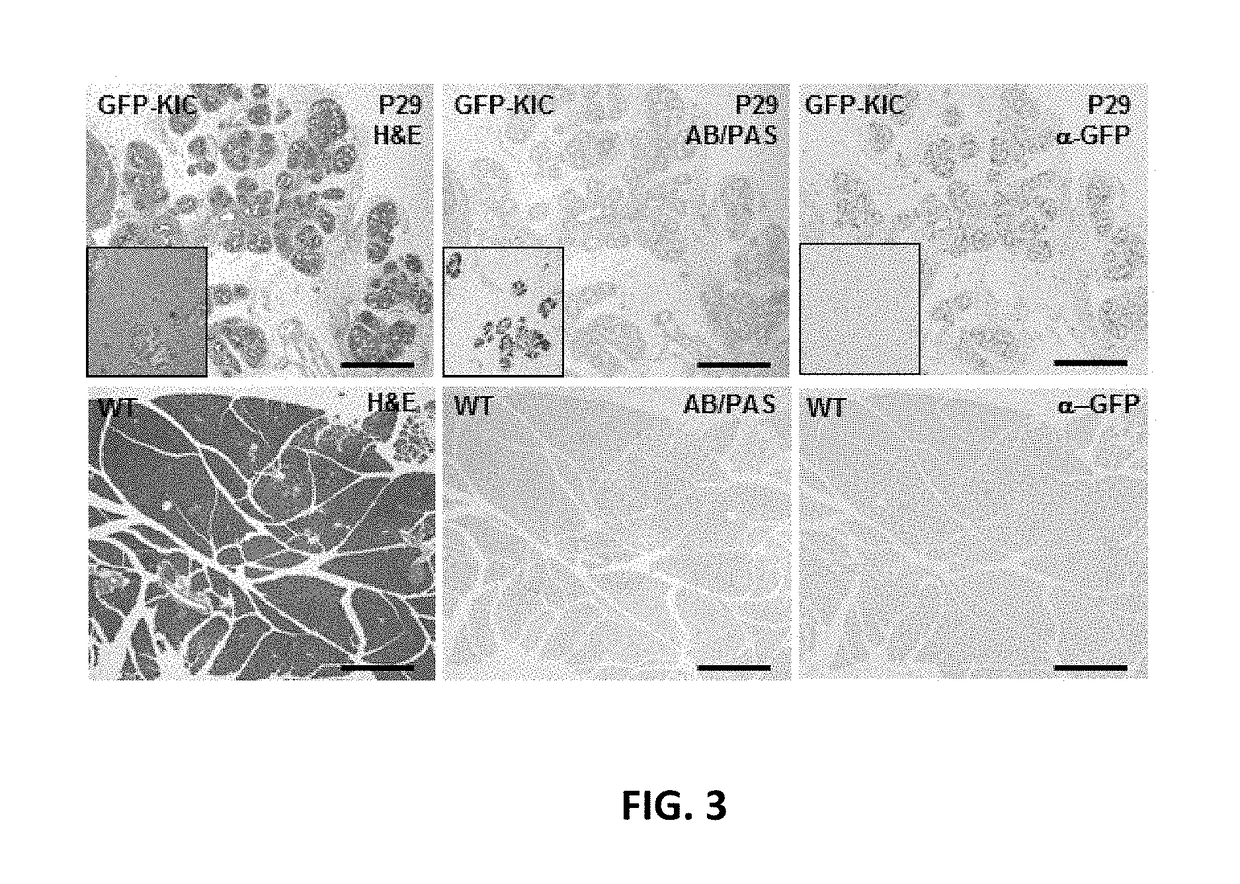Screen and use of therapeutics for pancreatic ductal adenocarcinoma
a technology of pancreatic ductal adenocarcinoma and therapeutics, applied in the field of medicine and oncology genetics, can solve the problems of limited progress in developing effective treatment, late onset of pda symptoms, and often resistance of tumors, and achieve the effect of inhibiting recurrence and prolonging remission
- Summary
- Abstract
- Description
- Claims
- Application Information
AI Technical Summary
Benefits of technology
Problems solved by technology
Method used
Image
Examples
example 1
Materials and Methods
[0219]Mouse lines and genotyping. KIC (p48Cre / +; KrasG12D / +; Cdkn2af / f); KC, (p48Cre / +; KrasG12D / +); IC (p48Cre / +; Cdkn2af / f); Rgs16::GFP; KIC, KIC mice were crossed with Rgs16::GFP BAC transgenic mice to generate Rgs16::GFP;p48Cre / +;KrasG12D / +;Cdkn2af / f (Rgs16::GFP;KIC) reporter mice. Genotyping was done using clipped tails before sacrifice and confirmed with spleen DNA after dissection. Mice were maintained at a 12 hr day-12 hr night cycle on normal chow ad libitum according to the rules and standards of UT Southwestern Institutional Animal Care and Use Committee. Rgs16 mice were identified by blue light excitation of GFP in brain of newborn pups or in retina of adult mice. Genotyping of KIC mice was done with the following primers: p48Cre (For: 5′-CCTGGAAAATGCTTCTGTCCG-3′ (SEQ ID NO: 1); Rev: 5′-CAGGGTGTTATAAGCAATCCC-3′ (SEQ ID NO: 2); Product: 392 bp), LSL-KrasG12D (For: 5′-CTAGCCACCATGGCTTGAGT-3′ (SEQ ID NO: 3); Rev: 5′-TCCGAATTCAGTGACTACAGATG-3′ (SEQ ID NO...
example 2
Results
[0230]Rgs16::GFP is a KrasG12D dependent reporter of PDA initiation and growth. The inventors introduced the Rgs16::GFP reporter into KC and KIC mice because PDA initiates in pancreatic duct-like cells, either following ADM or neoplastic growth of progenitor cells, anywhere from the head to the tail of the pancreas (FIGS. 1, 2) but not in the hepatopancreatic duct (FIGS. 9A-F) (Aguirre et al., 2003). The affected cell types are consistent with the expression domain of p48 (Ptfla) during pancreas development (Kawaguchi et al., 2002). Rgs16::GFP is expressed in embryonic and neonatal pancreatic ducts (Villasenor et al., 2010) and, in adults, in ducts early in the response to chronic high insulin demand and in mid-late gestation in pregnant females (Villasenor et al., 2010). Finally, endogenous Rgs16 is expressed in human PDA (TCGA, cancergenome.nih.gov / ; Kim et al., 2010).
[0231]Analysis of pancreata harvested from P29 mice demonstrated that Rgs16::GFP expression in pancreatic t...
example 3
Discussion
[0243]The dismal survival rate of patients diagnosed with pancreatic cancer justifies an intense preclinical effort to identify novel PDA therapeutics. GEMMs have significant benefits for drug screening, including recapitulation of all major stages of PDA and the complex interplay between precancerous neoplasia, adenocarcinoma, immune components, and stromal elements (Cook et al., 2012). The inventors used the KIC model because it is currently the most aggressive GEMM of PDA available (Aguirre et al., 2003). KIC mice harbor the two earliest genetic mutations common to most PDA patients: oncogenic mutations in Kras, which confer GAP-resistance (e.g., KrasG12D), and deletions of the tumor suppressor Cdkn2a. In the KIC GEMM, neoplasia initiate around two weeks of age and tumors (1-2 mm) develop in all untreated mice by P29. Furthermore, toxic and off-target drug effects inhibit growth of weanling mice and are easily measured as reduced body weight (FIGS. 20A-D). Although wean...
PUM
| Property | Measurement | Unit |
|---|---|---|
| time | aaaaa | aaaaa |
| delay time | aaaaa | aaaaa |
| delay time | aaaaa | aaaaa |
Abstract
Description
Claims
Application Information
 Login to View More
Login to View More - R&D Engineer
- R&D Manager
- IP Professional
- Industry Leading Data Capabilities
- Powerful AI technology
- Patent DNA Extraction
Browse by: Latest US Patents, China's latest patents, Technical Efficacy Thesaurus, Application Domain, Technology Topic, Popular Technical Reports.
© 2024 PatSnap. All rights reserved.Legal|Privacy policy|Modern Slavery Act Transparency Statement|Sitemap|About US| Contact US: help@patsnap.com










